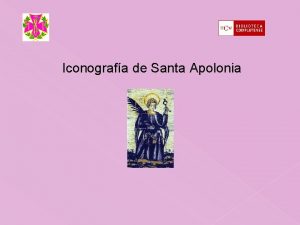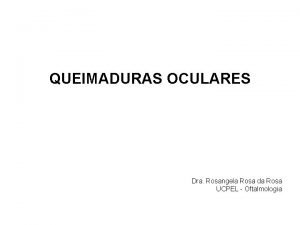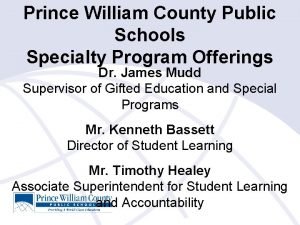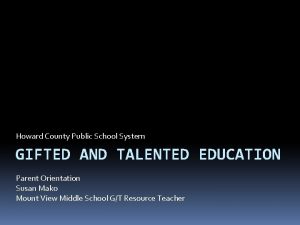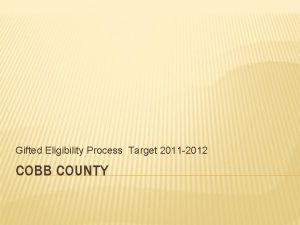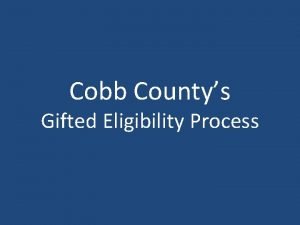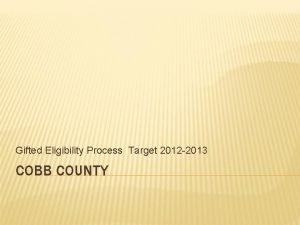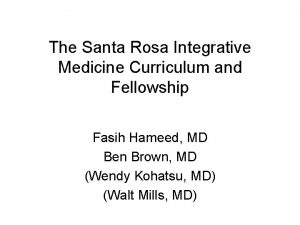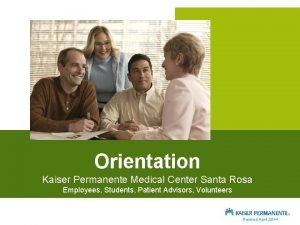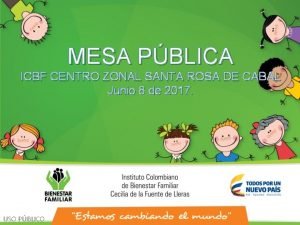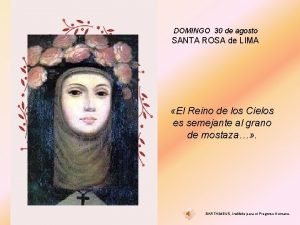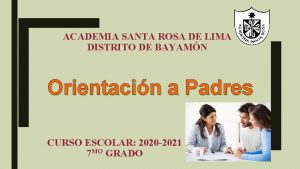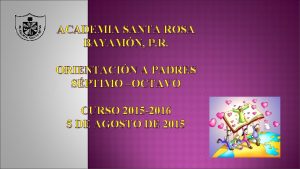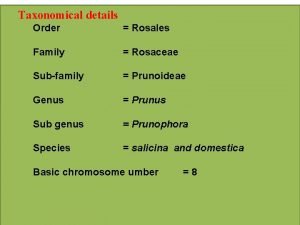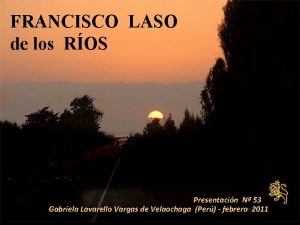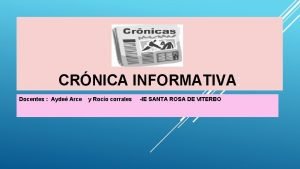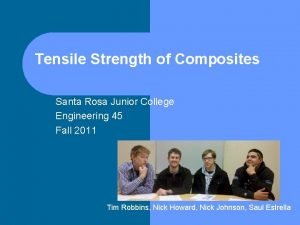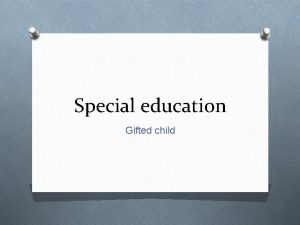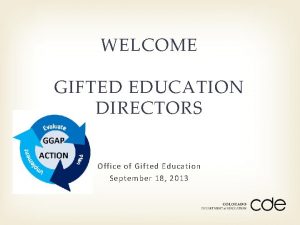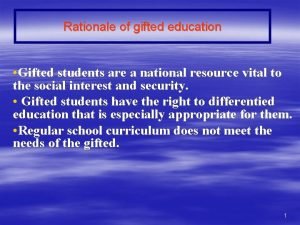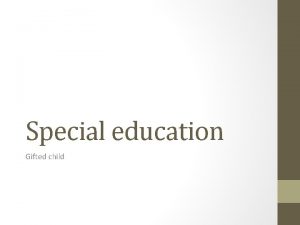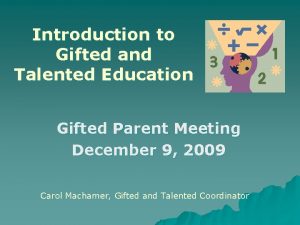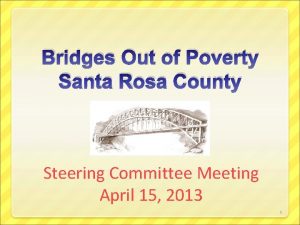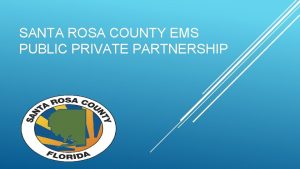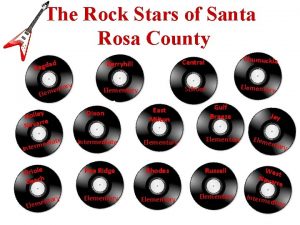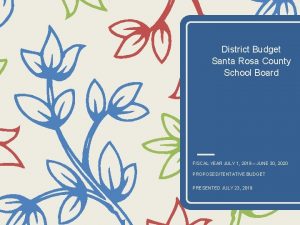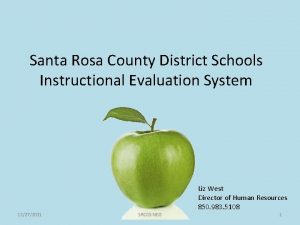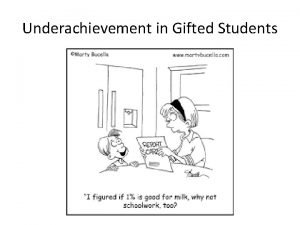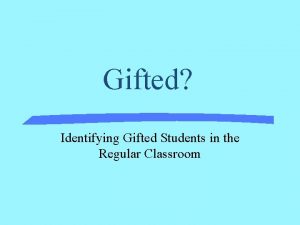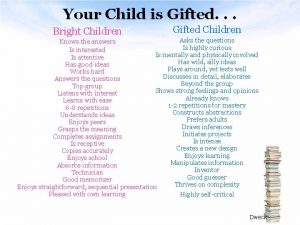Gifted Education in Santa Rosa County How are





















- Slides: 21

Gifted Education in Santa Rosa County

How are Gifted Students Identified? � 1. Teacher or parent requests screening. � 2. School Counselor administers screening instrument – KBIT-2 � 3. School Psychologist administers the Reynolds Intellectual Assessment Scales (RIAS) � 4. Student must earn a 130 or above on the RIAS � 100 = average, or the mean � 115 = one standard deviation above the mean � 130 = two standard deviations above the mean � A “snapshot” on a given day. 127 - 133 � 5. Students must exhibit a majority of characteristics on the SRC Gifted Characteristics Checklist completed by their classroom teacher, and must score at least 81 out of 160 possible points. � 6. The Educational Plan (EP) Committee must agree that the student needs a higher level differentiation of curriculum. � 7. EP is written, parents give consent for services, student begins gifted services.

Gifted Education �What it is: �*Teacher as coach �*Expresses creativity �*Project-based learning �*Research to determine both questions and answers surrounding an issue �*Enrichment in core subjects – math, reading, science, social studies �What it is not: �Repetition �Working through curriculum faster with no differentiation �Using the gifted learner as a tutor for the other students

3 Types of Gifted People • Strivers= High testers and teacher pleasers. Like structure (I. Q. 115 -130) These are our “talented” children who do not qualify for gifted services at the “snapshot” level of 130. • Superstars= Great at everything. Stereotypical Gifted (I. Q. 130+) • Independent= Creative, “Intellectual”, only interested in their own pursuits. Can become inventors, “serial employees” or dropouts. These children can be shining stars or become our “underachieving” gifted learners if they are bored or frustrated.

Common Myths about Gifted Education Myth: Gifted students don’t need help; they’ll do fine on their own Truth: Would you send a star athlete to train for the Olympics without a coach? Gifted students need guidance from well-trained teachers who challenge and support them in order to fully develop their abilities. Many gifted students may be so far ahead of their sameage peers that they know more than half of the grade-level curriculum before the school year begins. Their resulting boredom and frustration can lead to low achievement, despondency, or unhealthy work habits. The role of the teacher is crucial for spotting and nurturing talents in school.

Common Myths about Gifted Education Myth: Truth: Teachers challenge all the students, so gifted kids will be fine in the regular classroom Although teachers try to challenge all students they are frequently unfamiliar with the needs of gifted children and do not know how to best serve them in the classroom. The National Research Center on Gifted and Talented (NRC/GT) found that 61% of classroom teachers had no training in teaching highly able students, limiting the challenging educational opportunities offered to advanced learners. A more recent national study conducted by the Fordham Institute found that 58% of teachers have received no professional development focused on teaching academically advanced students in the past few years

Common Myths about Gifted Education Myth: That student can’t be gifted; he’s receiving poor grades Truth: Underachievement describes a discrepancy between a student’s performance and his actual ability. The roots of this problem differ, based on each child’s experiences. Gifted students may become bored or frustrated in an unchallenging classroom situation causing them to lose interest, learn bad study habits, or distrust the school environment. Other students may mask their abilities to try to fit in socially with their same-age peers. No matter the cause, it is imperative that a caring and perceptive adult help gifted learners break the cycle of underachievement in order to achieve their full potential. See ERIC digests on underachievement in gifted boys; underachievement of minority students.

Exceptional Student Education District-Wide � Total number of students in a gifted program as of 2/10/2013 is 766. � Total ESE students as of 11/15/2013 – is 3057 (tally does not include gifted). � District tally Pivot table located on webpage states 667 gifted but 766 is correct number as district tally reports only ‘PRIMARY’ Gifted only students while 766 tally reports all students w/ ‘ANY’ gifted programs and may have another primary exceptionality. � Statewide Gifted = 5. 27% of the total student population � Escambia County Gifted = 2, 253 or 5. 45%* � Okaloosa County Gifted = 1, 158 or 3. 84%* � *DOE numbers 10/2013

Instructional Models for Gifted Education �The Content Model – emphasizes the important of learning skills and concepts within a predetermined domain of inquiry. Content acceleration. �The Process-Product Model – places emphasis on investigatory skills, both scientific and social, in order to develop high-quality products. Collaborative. Teacherstudent as team. Consultation and independent work. �The Epistemological Model – focuses on exposing students to key ideas, themes and principles within and across domains of knowledge. Teacher as questioner. Discussion. Debate. Reading-reflection-writing. The nature of knowledge, its extent and validity. (Brown-Barge Model)

Types of Accommodations for Gifted Education �Curriulum Compacting – 1) defines goals and outcomes of a unit of instruction, 2) determines and documents which students have mastered most or all of a set of outcomes, 3) provides replacement strategies for material already mastered. �Class Acceleration – Accelerated placement options such as early entrance to Kindergarten, grade skipping or early exit should be considered for gifted students. (NAGC website)

Types of Accommodations for Gifted Education (cont. ) �Subject Area Enrichment The broadening of the scope of the curriculum beyond what is typically covered and/or increasing the depth of study. Enrichment does result in greater gains in learning for gifted students compared to gifted students who do not receive enrichment. (HNMS, WBMS) �Gifted Clustering – A group of 3 to 6 gifted students are clustered in a mixed-ability classroom. The teacher has had training in how to teach gifted students. Gifted clustering allows for a successful implementation of the PUSH-IN model for gifted education.

Types of Accommodations for Gifted Education (cont. ) �Push-In – An inclusive model where gifted teachers support classroom teachers to differentiate classroom curriculum, increasing the rigor of learning for gifted students on a daily basis while providing opportunities for all students. �Push-In (cont. ) Collaborative work, support for differentiation, development of curriculum, professional development and problem solving opportunities are key elements of successful implementation of the “Push-In” model.

Types of Accommodations for Gifted Education (cont. ) �Pull-Out – a program where gifted children are taken out of their regular classroom once per week and provided with enrichment activities and instruction. This is the model we are using in SRC elementary/primary/intermediate schools.

What does a day in a gifted class look like? Math Superstars Research Project-Based Learning Socratic Seminar – questioning, critical thinking Teacher as academic coach in exploration Creativity DEAR Learning Leadership where everyone is capable of leading • Group research and products • Thematic unit studies exploring depth of knowledge in all core areas • •

Instructional Models Used in Santa Rosa County Middle School Services Subject area - CONTENT Elementary Services– MODEL at WBMS and PROCESS-PRODUCT HNMS MODEL Elective - PROCESS*Pull-Out PRODUCT MODEL at *Push-In GBMS *Gifted Clustering No Gifted services/ Adv. Courses only at other SRC middle schools High School Services Virtual School is available at all levels No gifted services AP/Honors Courses

Delivery models being used in SRC �ELEMENTARY �Pull out model: DPS, DIS, GBE, HNP, HNI, OBE, PRE, Rhodes, WNI, WNP �Push in model: DIS �Satellite model: Rhodes (serves students from BREm Bagdad, EME, BHE, Chumuckla, and Rhodes) �MIDDLE �Subject area pull out: �HNMS – Gifted Science 6 -8 �WBMS – Gifted Social Studies 6 -8 �GBMS – Gifted Elective 6 -8 (numbers go down each year as other electives become available for the students to take)

Gifted Endorsed Teachers �ALREADY teach Core Curriculum Methodology �Courses for endorsement include: �*Nature and Needs of Gifted Children �*Curriculum Development for Gifted Children �*Guidance and Counseling of Gifted Children �*Education of Special Populations �*Theory and Development of Creativity

SRC Gifted Endorsed Teachers �SRC currently has 33 Gifted Endorsed Teachers �Thirteen schools currently offer gifted services. All services are delivered by Gifted Endorsed Teachers.

Gifted Delivery Models in Escambia County �Inclusion – General education classrooms where every student is identified as gifted. �Pull-out – Gifted students travel to the PATS Center (Program for Academically Talented Students) one full day per week for their gifted services. �Magnet School – Brown Barge Middle School for Gifted and Talented Learners. School Choice. Students who qualify and are selected in the lottery, travel from all over the county to BBMS. �IB Program – Open to Escambia County high school students, as well as students from Santa Rosa County.

Gifted Delivery Models in Okaloosa County �Each elementary school designs its own Gifted Education Program to meet the needs of the students. Each middle and high school offers a variety of Gifted Education courses including Gifted Studies. �In high school, Gifted Externships are another possibility for those in the program. Gifted Externships provide opportunities for field experience and research with a community professional which enhances personal growth and provides awareness of career options. �In addition, an IB Program is located at Choctawhatchee HS �Each school’s Gifted Education Program has been designed around the standards set forth by the National Association for Gifted Children (NAGC).

Recommendations Short Term • • • Trained Gifted Teachers General Ed Teachers trained to identify and differentiate for gifted learners (push-in? ) Continue to offer stipend Plan B Exploration Increase funding for teachers to use for gifted differentiation and instruction Subject Area Gifted Studies in ALL Middle Schools Revisit Standard Error of Measurement (Sem) which is used in both Escambia and Okaloosa Counties Group screen all second graders for giftedness as a pilot in 2014 -15 In conjunction with DOE, look at VAM scores so gifted teachers do not feel penalized. Long Term • • • Gifted Certified Teachers for AP and Honors classes in our high schools Train general education teachers in gifted/core curriculum methodology and pedagogy Implement a Plan B in SRC Expand second grade screening tests for giftedness to all schools Dedication to expanding and aligning services for gifted and talented students in SRC
 Insidan region jh
Insidan region jh Santa apolonia santa rosa
Santa apolonia santa rosa Rosangela rosa da rosa
Rosangela rosa da rosa Prince william county high school specialty programs
Prince william county high school specialty programs Howard county gifted and talented
Howard county gifted and talented Cobb county gifted program
Cobb county gifted program Cobb county gifted eligibility process
Cobb county gifted eligibility process Howard county gifted and talented
Howard county gifted and talented Cobb county target program
Cobb county target program Integrative medical clinic santa rosa
Integrative medical clinic santa rosa Kaiser
Kaiser Bienestar familiar santa rosa de cabal
Bienestar familiar santa rosa de cabal Oracion a santa rosa de lima
Oracion a santa rosa de lima Academia santa rosa de lima blog de maestros
Academia santa rosa de lima blog de maestros Academia santa rosa de lima
Academia santa rosa de lima Misioneras de santa rosa de lima
Misioneras de santa rosa de lima City of santa rosa jobs
City of santa rosa jobs Rosaceae order
Rosaceae order Pediatric asthma care near santa rosa
Pediatric asthma care near santa rosa Quien pintó la pascana
Quien pintó la pascana Frases de santa rosa de viterbo
Frases de santa rosa de viterbo Tap plastics santa rosa
Tap plastics santa rosa

